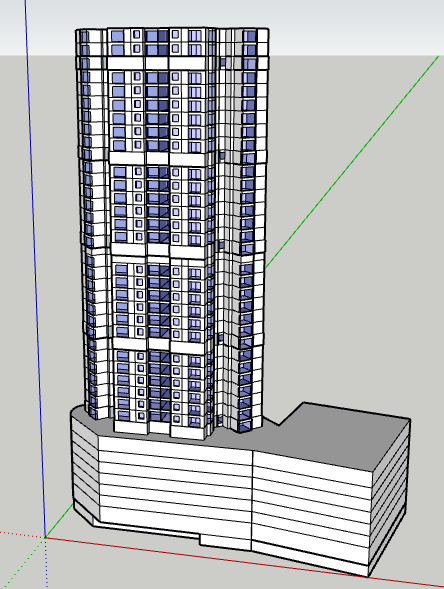Hello community,
I have newly joined in this forum. I wanted to get some clarification about how to analyse daylight simulation for larger buildings such as 31 floors residential building with typical floors. I have watched Honeybee Workshop @PennDesign April 2014 which is here for getting basic knowledge on Honeybee Toolkit for Grasshopper. I am attaching a image of my model which I need to do daylighting simulation.
Anirudh P,
Design2Occupancy Services LLP.
Hi @Anirudh_P,
Depending on what you need the simulation for.
if LEED/ BREEAM etc. you need to do the whole building, probably floor by floor.
If just a study, I would simply select the lowest floor with windows/ or iterative floor, and select representative rooms with orientations and then run your optimization study on the selected ones.
BEst
Peter Z
Thanks @PeterZatko for guidance.
- I need to achieve daylight illuminance in range of 110 to 2200 lux in a clear sky condition on 21 Sep at 12 noon.
- Actually the tools have been changed from past releases to present. I can’t understand which tool I need to use.
Please help me in this if you can.
Thanks in advance.
Anirudh P.
Hi @Anirudh_P,
can you specify where you need to achieve it?
And I think you refer to UDI 100-2000lx.
The name of the components didn´t change especially for Daylight, that´s for sure.
this is the video you´re looking for https://www.youtube.com/watch?v=BqbCkjMYxdk&list=PLkjfDmSc5OryXkWSt57ltJFU4qXD5ss1v&t=0s&index=5
Thanks @PeterZatko for video link. Its actually in regularly occupied spaces.
- How I can define new Radiance Materials, because Default Radiance Materials is missing in tools.
- Please help me regarding how to insert windows. I have seen the procedure. But its long to do for my building. Because there are so many windows per floor.
Hi @Anirudh_P,
Do you have any knowledge about Radiance, and Radiance materials ?
If yes, you can simply input the material defined as a text file to_RadMaterial.
If no, you should start with some Radiance tutorial, and then the material definition can be taken from color picker.
For your second question, is what I referred to already, if you have iterative floors (each floor have same floorplan), take the lowest one and do the simulation just for that one.
And yes it´s time consuming that´s why one should be paid good if doing Daylight or energy simulations.
Best
Peter Z
2 Likes
Thanks @PeterZatko for your help. Will be in touch with you if further help is needed.
Best Regards,
Anirudh P.
Are there any webinars upcoming for “Daylighting Simulation using Honeybee for Grasshopper”?
Thanks and regards,
Anirudh P
Thanks @mostapha for link. I have actually referred this. I have exported my model from Ecotect 2011 to a radiance file (.rad). Is there any workflow to use this file in Honeybee and do daylight analysis.
Thanks and regards,
Anirudh P
You can but why would you do that? If you have the model in Ecotect then you should be able to set it up for Radiance. If you want to use Honeybee you can Just bring the geometry in Rhino and then use Honeybee to set the materials, etc. You can use import rad component for importing Radiance files into Grasshopper but that can be slow for large models.
@mostapha
I have already set the materials too. I have done that and have tried to seperate building by floors. But the tool shows an error that the input geometry should be in solids.
Thanks,
Anirudh P
Can you share your rad file?
@mostapha
It is in my laptop. I will send you within half an hour.
Thanks,
Anirudh P
@mostapha
This is my radiance file for my model which is compressed in a zip format.
model.zip (174.1 KB)
Regards,
Anirudh P
I had a quick look to your model. It only has four materials. I would export the model from Ecotect to a format that you can import to Rhino and then re-assign the materials inside Honeybee based on layers.
You can also import the rad file into Rhino but that doesn’t make a difference in this case and actually because the curves from Radiance export are self-intersecting you will need so extra work to convert them to surfaces. Here is the imported model. I didn’t convert the curves to surfaces: daylight_model.zip (1.2 MB)
@mostapha
How to convert curves to surfaces in Rhino all at a time? Is it possible?
Thanks,
Anirudh P
@mostapha
How to manually add windows to a 3D model created in Rhino? Is there any example file for this?
Thanks,
Anirudh P
